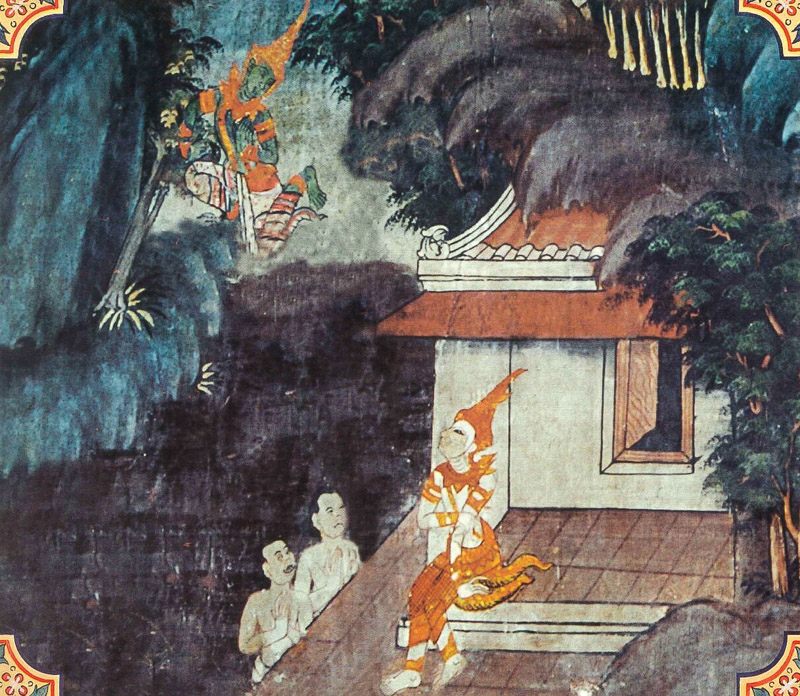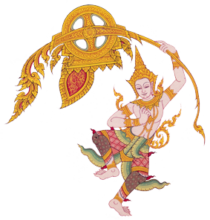
The Bodhisatta was once an ascetic. King Kalinga was a fierce ruler with a strong army, and he wanted to fight a war. He sent his four beautiful daughters out in a carriage to travel around India, hoping that a king would want them and be willing to fight for them. But every king they encountered would not even let the women into their cities in order to avoid any risk of conflict. When the daughters came to King Assaka’s kingdom, he shut the city gates, just like every other king had done, but his wise advisor Nandisena declared that to maintain the kingdom’s pride and reputation as courageous, they should fight. Nandisena convinced King Assaka he would be victorious in any battle, so he took the four women as wives.
King Kalinga was excited by the news and sent his army out immediately. Nandisena sent a message that they would battle at the frontier between their kingdoms in two days. The Bodhisatta lived in this border region, and Nandisena went to ask him who would win the war. The Bodhisatta answered that he could not know, but Indra, king of the gods, was coming to visit soon, and he would know the answer. Indra told him King Kalinga, who had a white bull as his guardian deity, would defeat King Assaka and his black bull guardian. This answer worried King Assaka, but Nandisena was not discouraged in the least and still believed his plan would lead to victory.
On the day of the battle, Nandisena assembled his troops atop a mountain and told them the way to victory was for them to throw themselves off the cliff, sacrificing their lives for their king. As the men charged forth to do so, Nandisena stopped them and said it was only a test of their bravery and loyalty. Then he led them to the battlefield filled with confidence. The two kings faced off, their respective guardian deities, visible only to themselves, standing in front of them. At this time, Nandisena told King Assaka to jump off his horse and strike the white bull with his spear, and the soldiers ran to join this attack. With his white bull guardian dead, King Kalinga cursed the Bodhisatta, who he assumed had lied about the outcome, and fled in fear.
Nandisena sent a message to King Kalinga telling him that if he did not want another defeat, he should send a bride-price for the four daughters promptly. King Kalinga did so, and from then on the two kings lived together peacefully.
When Indra next came to visit the Bodhisatta, he asked why the prediction about the battle had been wrong. Indra answered that Nandisena’s cleverness overcame King Kalinga’s strength, and wisdom is more important than power.
In the Lifetime of the Buddha
A clan arranged a marriage between two expert debaters so they would have clever children who could carry on their skills. Their five children, four girls and a boy, grew up learning one thousand different topics for debate. Their parents told the daughters (who had been King Kalinga’s four daughters in earlier births) that when they grew up, if they ever lost a debate to a layman they should marry him, and if they lost to a holy man they should become his disciple. While the son remained in his hometown, the four daughters wandered town to town debating everybody they could.
When the daughters reached the town near where the Buddha lived, they stuck a rose apple tree branch in a pile of dust by the city gate and told some boys that if anyone wanted to debate, they should crush the branch under their feet. While the daughters were off collecting alms, one of the Buddha’s top disciples, Sariputta (who had been Nandisena in an earlier birth), walked by and saw the challenge. He told the boys to crush the branch for him and send the women to find him. Soon a great crowd gathered at the Buddha’s monastery. The women presented Sariputta with all one thousand topics, and he solved every one. Then he stumped them with a question of his own. Defeated, they ordained as disciples that same day, and reached arahantship soon after.
Later, when the Buddha heard some of his disciples discussing how Sariputta had converted the women, he told them this story so they knew that in the past Sariputta had also taken in these four women following a victory.
